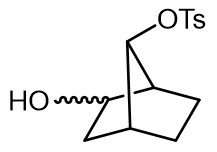Intramolecular nucleophilic catalysis is a fascinating concept that involves neighboring group participation (NGP), which refers to the influence of a neighboring group on the reaction rate and stereochemical outcome. In this context, NGP can significantly alter how reactions proceed, particularly in nucleophilic substitution reactions.
Consider a cyclopentane ring with a methyl group and a chlorine atom. When an azide ion acts as a nucleophile, it can perform an SN2 reaction by attacking the carbon bonded to chlorine, resulting in the displacement of the chlorine atom. This process leads to an inversion of configuration at the carbon center, where the azide ion adopts a wedge bond orientation.
In another scenario, the azide ion faces steric hindrance due to a neighboring sulfur atom with a bulky benzene ring. This steric effect complicates the nucleophilic attack, making it more challenging for the azide ion to displace the chlorine. However, if the azide successfully attacks, the bond configuration will again switch to a wedge bond.
Intramolecularly, the sulfur can utilize its lone pairs to attack the carbon attached to chlorine, facilitating the formation of a cyclic intermediate. This reaction also results in the inversion of the bond configuration. The sulfur atom, now forming three bonds, carries a positive charge. Subsequently, the azide ion can attack the less substituted carbon of the resulting three-membered ring, which is under angle strain, similar to the mechanism seen in epoxide ring openings. This attack leads to another inversion of configuration, restoring the azide ion's original orientation.
When comparing the rates of these reactions, the intramolecular process is the fastest due to the proximity of the nucleophile and the leaving group. The azide ion's attack from the opposite side in the second scenario results in a moderate rate, while the reaction involving the bulky sulfur and benzene ring is the slowest due to significant steric hindrance. Overall, the presence of neighboring groups can greatly influence both the rate and stereochemistry of nucleophilic reactions, highlighting the importance of molecular structure in chemical reactivity.



